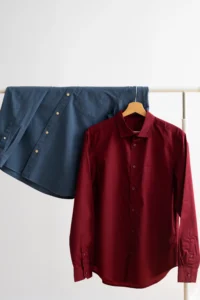
Starching your shirts is a great way to achieve a crisp, polished look that lasts all day. But how often should you actually starch your clothes? While the answer can vary depending on personal preference, fabric type, and wear, understanding the right balance can help maintain your shirts’ sharpness without damaging the fabric.
Why Starch Your Shirts?
Starching not only helps keep your shirts wrinkle-free, but it also adds structure and enhances the overall appearance. It creates a crisp, formal look that’s ideal for business meetings, formal events, or any occasion where a polished appearance matters. Additionally, starching can make ironing easier and help prevent future wrinkles.
How Often Should You Starch Your Shirts?
The frequency of starching depends on several factors, including the fabric of the shirt, how often it’s worn, and personal preference. Here’s a general guideline:
- Light Starching (Occasional Use): If you’re looking for a subtle, professional finish, light starching once every few wears should be sufficient. This works well for shirts made from cotton or a cotton-blend, which already hold a good structure. Over-starching can make the fabric stiff and uncomfortable, so using a light amount every 2-3 wears can help maintain the crispness without overdoing it.
- Medium Starching (Regular Use): For those who prefer a more rigid, crisp look, applying medium starch more regularly (about once a week) can keep your shirts sharp and well-pressed. This is ideal for business professionals or those who frequently wear formal attire. Medium starch helps keep wrinkles at bay while still offering flexibility in movement.
- Heavy Starching (For Maximum Crispness): Heavy starching is best for occasions when you need your shirt to look perfectly crisp and structured, like interviews or special events. However, using heavy starch too often can make the fabric feel too stiff, leading to discomfort and wear over time. Limit heavy starching to special occasions or when you really need your shirt to stand out.
Tips for Starching Your Shirts:
- Use the Right Starch: There are various types of starch available, including aerosol sprays, liquid starch, and powder. Aerosol sprays are convenient and provide even coverage, while liquid starch offers more control over the level of stiffness.
- Don’t Overdo It: While a crisp shirt is great, too much starch can damage the fabric. Always test on a small section before starching the entire shirt.
- Iron Immediately After Starching: To get the best results, iron your shirt immediately after applying starch to prevent it from becoming too stiff.
Conclusion
Starching your shirts is all about balance. Light starching every few wears is ideal for maintaining a fresh, crisp look without damaging the fabric. For those who prefer a more formal appearance, medium or heavy starching can offer the structure you need for special occasions. As long as you avoid over-starching, your shirts will stay looking sharp and last longer.
Ready to give your shirts that perfect crisp finish? Experiment with different levels of starch and find the ideal routine that works for you. If you’re looking for high-quality starch or clothing care products, visit Firefly Campus Laundry today and get everything you need for a perfectly pressed look!
 Starching clothes is a popular method for achieving a crisp, polished look, but does it actually help in preserving the longevity of your garments? Many people use starch to make their clothes appear neater and to reduce wrinkles, but what about the potential for wear and tear? In this post, we’ll explore how starching affects your clothes and whether it can truly help prevent damage over time.
Starching clothes is a popular method for achieving a crisp, polished look, but does it actually help in preserving the longevity of your garments? Many people use starch to make their clothes appear neater and to reduce wrinkles, but what about the potential for wear and tear? In this post, we’ll explore how starching affects your clothes and whether it can truly help prevent damage over time. What is Starching?
What is Starching?

